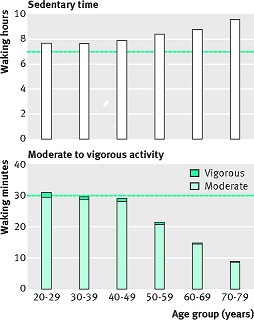In a survey of over 30,000 people aged 50+, across 12 European countries, more than one in four females and just over one in six males met the criteria for being pre-frail. In the same study (SHARE) published in 2010, over 7% of females and 3% of males were classified as frail.
The question is not how common frailty or even pre-frailty is now, or if nothing changes, in the future, but how we as individuals can avoid becoming part of this group. What can we do or stop doing now that will make a difference?
Why might this be of interest to us as we reach middle age?
Two reasons:
Firstly sedentary behaviour is not only a parameter of being frail it is also lethal. The World Health Organisation has calculated that sedentary behaviour kills as many people worldwide as smoking or obesity! This is because being sedentary increases the risk of heart disease, diabetes, colon and breast cancer.
The mechanism partly relates to the metabolic consequences of being idle. Sitting too much adversely affects our waistline and weight, systolic blood pressure, glucose metabolism, HDL cholesterol and triglyceride levels.
Secondly sedentary behaviour is increasing amongst the general population, and rises with age.
The table adapted from an article in the BMJ in 2015, summarises data collected from 7000 US adults aged 20 – 79 years of age whilst wearing accelerometers.
It shows the average number of waking hours spent being sedentary (on the top bar chart) and minutes spent undertaking moderate or vigorous exercise (blue-green on the bottom chart), each day, by age group.
Similar results have been reported in a large study of older adults in the UK.
Collectively, the accelerometer findings from the US and UK indicate that even when exercise intensity is adjusted for an age related decline in physical capacity, only 10-15% of free living, older adults are meeting the minimum standard for “sufficient activity”.
7 hours is the cut-off point above which sedentary time is considered to be harmful. We can also see that very few of the groups meet the recommended amount of 30 minutes of daily exercise.
Even though most adults overestimate the amount of physical activity they undertake, the evidence shows that as we get older the percentage of us who undertake even a minimum of physical exercise has remained static for years. As the data in the Table shows this starts to occur in our late 40s and early 50s. Irrespective of whether we are working or retired, by the time we reach 70 only about one in five of us exercise and this decreases even further when we reach 80.
The prevalence of being inactive increases sharply as we reach 70. Many older adults spend more than 10 hours a day of waking time either sitting or lying down.
In a nutshell: Not enough people develop an exercise habit in middle age and this decreases the older we get.
As we said sedentary behavior and the frailty syndrome are linked but so is disability.
Frailty is characterized by diminished strength, endurance and (physiologic) function that increase an individual’s vulnerability to dependency and death.
Disability can be measured by the level of difficulty associated with carrying out everyday activities of daily living. These can include the ability to dress, get out of bed, eat, walk, groom, reach out, grip, perform errands and bathe.
Now the good news: frailty, and certainly pre-frailty, depending on the cause(s), can be reversible. Sometimes this may require medical and/or therapy interventions.See: Approaching 50: How Frail are you?
Two ways to get started:
- Get out of the house! Increase your social ‘mobility’. Research has shown that if we become reclusive we increase the risk of a more rapid transition from pre-frailty to frailty. After adjusting the results for those who have chronic disease, physical disability or psychosocial issues, those who leave their home four or more times a week decline at a rate three times slower than those who don’t leave their home at all. Getting out does equate with being more physically active and ‘interested’ in other life events.
- Move and stand more often; if inactivity/being sedentary has become habitual or includes an element of pain avoidance, then before you consider a graduated exercise program just increase your level of general activity. See ’10 Tips for reducing your sitting time’
This can be easier to achieve than you might think. Then consider a gradual increase in physical exercise aimed at improving balance, strength and aerobic fitness. Further information on how to do this is included in ‘Moving towards a life I love’ series and ‘Habit-for-Habit series’.
Key messages:
- Both Frailty and more importantly Pre-frailty can be defined and measured.
- As we have seen across Europe Pre-frailty is increasingly common after we approach 50.
- We can do something now to reduce or even reverse the risk of increasing frailty.
Part 3 in the Fries or Fried series describes a simple way measuring your frailty risk and what to do about it.


Sorry, comments are closed for this post.